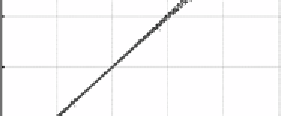Geoscience Reference
In-Depth Information
H < F bcL
4/3
Z
1
1/3
(4.18c)
where
F
is the geometry factor, which is instantly provided by the trained network
after input of the geometric measurements. Applying self-learning methods for a
quick evaluation of (geometric) variations is a promising new approach.
L
L
2
2
pipe
pipe
H
H
prediction
prediction
Z
2
Z
2
1
1
sand
sand
Z
1
Z
1
Z
4
Z
4
coarse sand
coarse sand
check
check
Z
3
Z
3
1
1
2
2
(a) (b)
Figure 4.7 ANN for a specific geological schematisation (Sellmeijer)
application 4.1
Consider a sand layer of
H
= 10 m thick and water table
h
about 1 m under the
ground surface. The known properties of soil and groundwater are:
s
= 25.3
kN/m
3
,
d
= 14.6 kN/m
3
,
n
= 0.42,
h
c
= 0.3 m. A corresponding
vertical soil pressure diagram is shown in Fig 4.8. Next, the question is what effect
a groundwater lowering of
w
= 10 kN/m
3
,
h
= 1 m may have on soil stress and corresponding
deformation of the soil.
Lowering the groundwater table with
h
will decrease the pore pressure with
u
=
h
and increase the vertical effective stress with
v
'
. Using the effective
w
stress principle for general saturated soil (
s =
1,
=
1), it provides the following
elaboration
v
=
v
'
u =
(
z-h
h
c
)
d
(
h-h
c
)
v
' =
(
z-h
h
c
)
d
(
h-h
c
)
-
w
(
z-h
)
=
'
(
z-h
)
(1
-n
)
s
h
(
-
(1
-n
)
s
)
h
c
=
((1
-n
)
s
-
'
)
h
'z
(
-
(1
-n
)
s
)h
c
=
(1
-n
)
w
h
'z
(
-
(1
-n
)
s
)
h
c
This result shows that a lowering of the groundwater table by
h
gives an
increase of the vertical effective stress by
v
' =
(1
- n
)
h
w
which is precisely the buoyancy force of a soil height of
h
, i.e. the solid volume
(1
-n
)
h
times
w
.



















































Search WWH ::

Custom Search